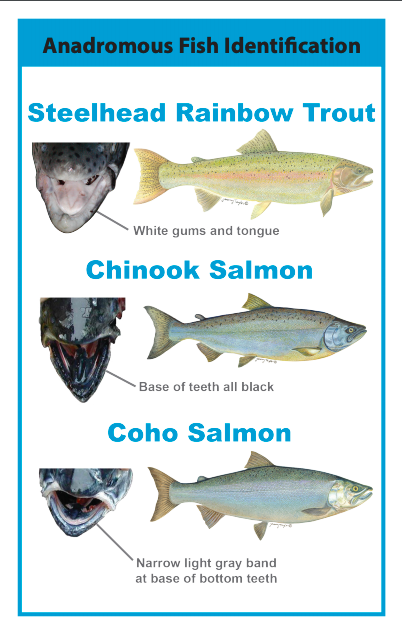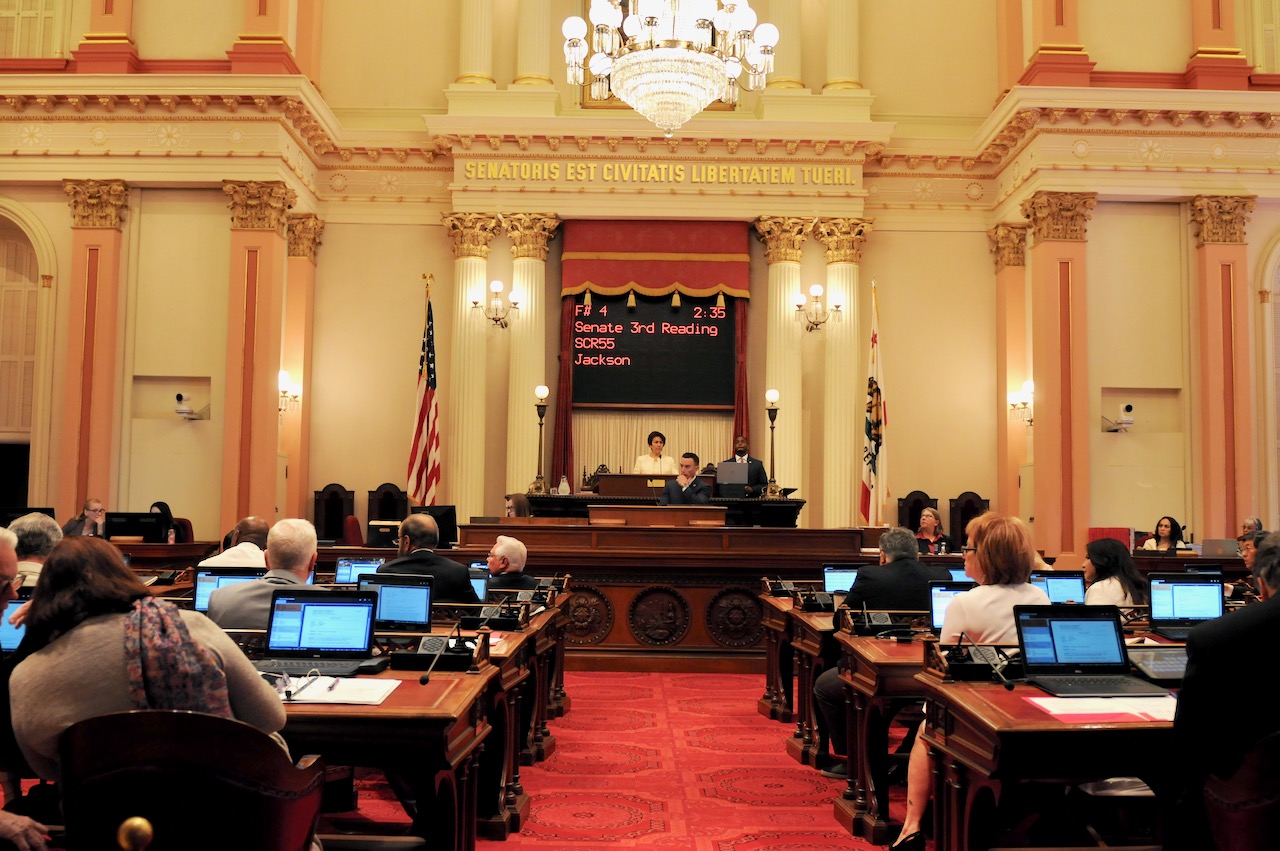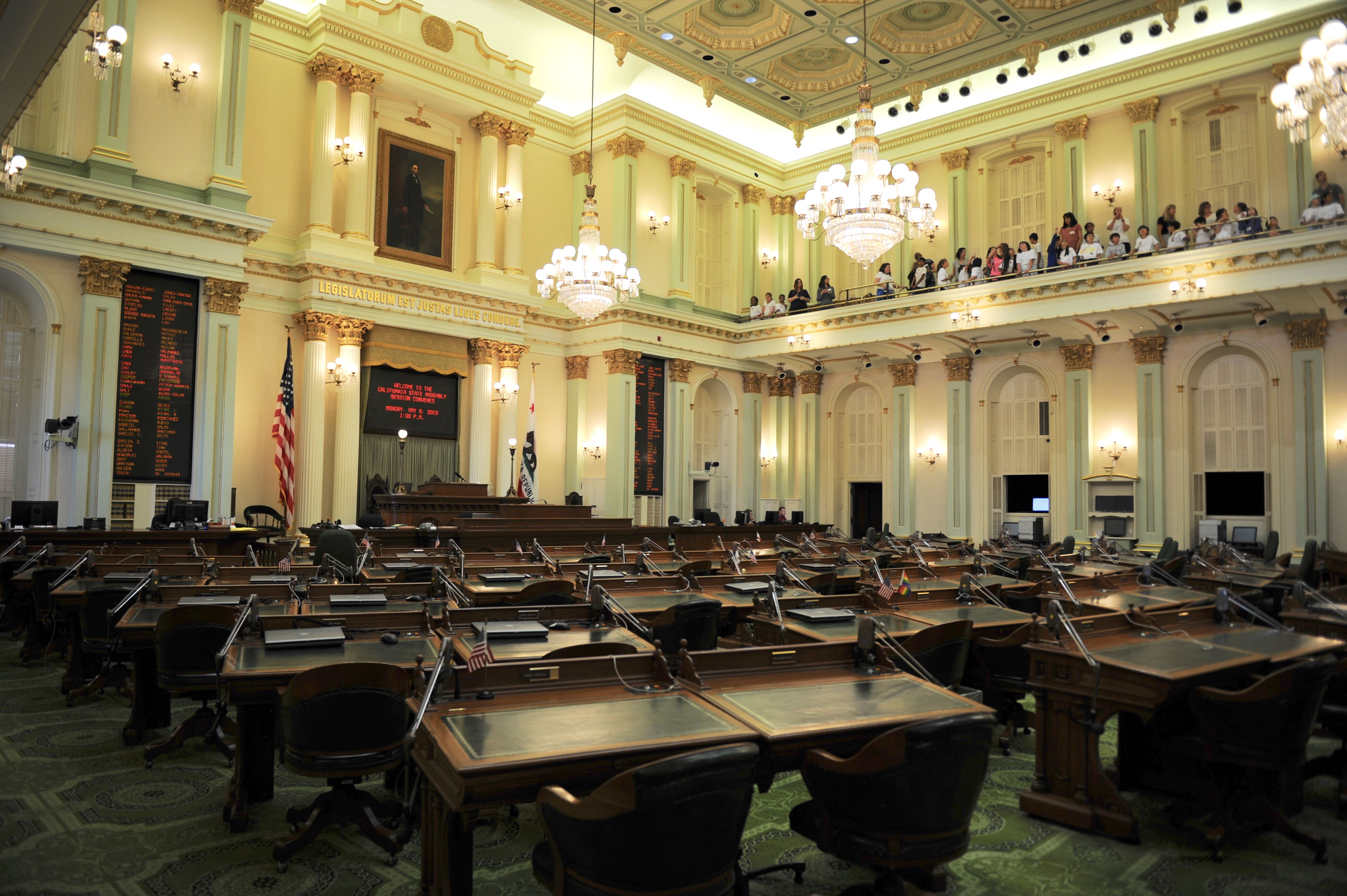
CA Sport Fishing Regulations. (Photo: nrm.dfg.ca.gov)
The Biggest Untold Reason for the Decline of Salmon
Water for Salmon, Salmon for Bass, Bass for Anglers, and Farmers Don’t Farm
By Edward Ring, February 7, 2023 6:30 am
As Californians dig out from several major storms just since December, major reservoirs in the state are already filled to within 86 and 104 percent of their historical average for this date, and the Sierra snowpack sits at 205 percent of normal. With additional precipitation likely before the end of California’s attenuated rainy season, and massive projected snowmelt poised to cascade downstream later this spring, water managers are already deciding what to do with the all this water.
To the uninitiated, such a policy decision might seem obvious: Once summer is imminent, and no more storms ought to threaten to overwhelm the spillways and cause flooding down in the valley, let the reservoirs fill to capacity. Save another five million acre feet behind the dams. But when it comes to water policy in California, complexities are layered atop complexities, and nothing is obvious.
Water management in California revolves around several distinct priorities that are often in conflict. Reservoirs provide flood control and store water for delivery via aqueducts to farms and cities, but they also have disrupted the natural flow of the rivers they span. As a result of in-stream dams, the aquatic environment is irrevocably altered. California’s water managers now have to balance the water requirements for food and people against the need to preserve a viable habitat for aquatic species.
For years, controversy has flared over just how much water should be released to preserve endangered species of fish, and how much should be reserved for farm irrigation and urban water agencies. One of the most critically endangered species of fish are the native salmon. This anadromous species of fish was once so abundant that hundreds of millions would hatch from eggs in the headwaters of California’s rivers and fight their way to the ocean, then after a few years return as adults by the millions to fight their way back to those spawning grounds.
Today, many of those spawning beds in California’s upper watersheds are blocked by dams. While some streams remain unobstructed and fish hatcheries raise millions of fingerlings for release downstream each year, California’s salmon population is a fraction of what it was. There is concern the fish could disappear altogether from California’s rivers.
Maintaining a hospitable environment for salmon doesn’t merely require adequate flow in the river during the spawning run upstream, or the subsequent migration of fingerlings downstream to the ocean. The temperature of the water in the river is also a factor. Salmon don’t tolerate water hotter than around 68 degrees, which in shallow waters during a hot summer can be easily exceeded. To cope with this, more water has to be released, preferably from deep reservoirs like the massive Lake Shasta, from which the water initially entering the river is much colder.
If you care about salmon, these gyrations make sense, but during drought years they come at a cost that many of California’s farmers would consider existential. Over the past few decades, and especially over the past few years, as withdrawals from rivers for irrigation were increasingly limited for environmental reasons, farmers were forced to pump groundwater. The resultant overdraft was compounded by the fact that using river water for flood irrigation in many cases was used to replenish those same aquifers.
What frustrates many of California’s farmers is the wisdom they have acquired over generations seems to be dismissed as folklore by the experts, hired by environmentalist activists, that inform legislators and regulators. But farmers in California never wasted water. They know when the ground is thirsty and able to percolate flood irrigation to recharge aquifers. Orchardists understand the water saving benefit of drip irrigation but also understand that each year, in most cases, there is a moment when a half-foot of flood irrigation will percolate to aquifers, flush away accumulated salts, eliminate gophers, and saturate the earth for a winter cover crop.
California’s family farmers, who have watched the rivers naturally rise and fall for countless seasons, also know that in dry years the salmon don’t run. The salmon instinctively sense if the rivers and streams are running dry, they stay in the ocean, and they wait for a wet enough year to make the final journey back to their spawning headwaters.
The Underreported Variable – Bass Eat Salmon
An almond farmer in the San Joaquin Valley who once worked as a fisheries biologist is Christine Gemperle. She shared a revealing story about salmon in California’s rivers, and what may constitute a greater threat to their survival than reservoirs and warmer waters could ever be. Gemperle participated in radiotracking studies back in 2000, where they were tagging salmon smolts (youthful salmon that have migrated from their spawning grounds into estuarine waters en-route to the ocean). As they monitored the smolts, they noticed significant numbers of their trackers moving upstream. This would be completely contrary to the natural path of smolts, since their goal is to make it to the Pacific Ocean.
As it turned out, the trackers, along with whatever remained of the smolts, were in the stomachs of striped bass.
This evidence, that striped bass eat salmon, has probably been known by anglers ever since striped bass were introduced to California’s rivers over a century ago. But marine biologists have had evidence of this for over 20 years.
A recent article written explicitly on this topic, from an expert source, provides an example of current thinking on the issue of striped bass and salmon in California’s rivers. Titled “The Delta Divide: Bass Trends In Salmon Migration Corridors,” the article opens by clearly stating the problem:
“Recent research has established that very few juvenile Chinook salmon survive the migration from their birthplace in California’s Central Valley tributaries, through the Sacramento-San Joaquin Delta, and out to the Pacific Ocean. Records from rotary screw traps on the Stanislaus and Tuolumne rivers show that most young salmon do not even make it as far as the San Joaquin River, still hundreds of miles away from the Golden Gate Bridge. Numerous elements contribute to the low survival of juvenile salmonids, including habitat alteration, pesticide pollution, and predation by non-native fish.”
And predation by non-native fish. But how much of a contributing factor is this predation? How decisive is it in affecting salmon populations?
That question is not answered. This article does not suggest that bass are the primary problem with salmon survival. Here’s as close as it gets: “Striped bass, on the other hand, were not frequently recaptured during this study. This lower rate of recapture is likely due to the highly mobile nature of striped bass, but future detection of tagged individuals at PIT tag antennas, in long-term surveys, or by other predator research projects, may help uncover their seasonal movement patterns. Genetic and visual analyses of the diet samples have not yet detected any Chinook salmon, but 43% of collected gut samples contained other fish, including both native and non-native species.”
Another San Joaquin Valley farmer told me the consulting firms that conduct studies of aquatic species in California’s rivers cannot point the finger at striped bass because that would undermine the larger environmentalist agenda to continue to mandate higher river flow as well as anger the bass anglers. He claimed these experts cannot be forthright because it will offend their clients.
Gemperle, in a follow up email, corroborated this farmer’s claims, writing, “It is no secret that non native bass species (large mouth, small mouth and especially striped bass) eat juvenile salmon. What most people don’t know is that it was originally documented in the year 2000 and it has taken 23 years for it to be acknowledged as a huge hurdle in the salmon population’s recovery if that is even possible.”
In a November 2022 presentation by the state’s Delta Lead Scientist Laurel Larsen to the Delta Stewardship Council, titled “The Role of Water Quality in Salmon Predation,” there wasn’t a single mention of striped bass. Larsen explored competing hypotheses regarding what habitat variables render salmon most vulnerable to predation, with the common emphasis being that California’s rivers need more flow and cooler water temperatures.
In general there seems to be consistent rejection of the theory – evident in plain sight – that salmon smolts are bait for bass. In a 2016 article published by the San Jose Mercury, UC Davis researchers are quoted as saying that even if bass populations are reduced, other predators will take their place. This seems fishy. Environmental remediation invariably prioritizes removing invasive species, often going to extreme lengths to do so. Why are striped bass exempt from the environmentalist penchant for eliminating invasive alien species?
Water for Salmon, Salmon for Bass, Bass for Anglers, and Farmers Don’t Farm
One might find a clue to this mystery in the 2012 recommendation from the California Department of Fish and Wildlife to triple the catch limit and reduce the size limit for bass. Experts there had clearly determined this would help with salmon recovery. But the state Fish and Game Commission immediately rejected the plan. Why?
We may begin by recognizing that every agency in California answers to special interests. When it comes to any state agency tasked with managing California’s rivers the most influential special interest is environmental activists. But there is considerable overlap between the agenda of, for example, environmentalist groups such as the Audubon Society, and groups advocating for the sport hunting and fishing industry such as Ducks Unlimited.
One can only speculate as to the discussions that occur behind closed doors between these and many other advocacy organizations, their lobbyists, their litigators, and their campaign strategists. But this powerful alliance shares a common goal: Leave more water in the rivers. Anglers want the bass protected because fishing for trophy bass is an extremely popular sport in California. Environmentalists welcome the support from sportfishing groups because it adds political weight to their ongoing pressure on water managers to prioritize water to maximize river flow and minimize river temperature.
And so this year, just as in every year, increasing percentages of available stored water will be sent down the river in hopes that will enable more salmon to survive the gauntlet of voracious bass. The cost of this choice is measured in the tens of billions of dollars. In dry years, which hundreds of years ago were just as common as they are today, the salmon simply stayed in the ocean. Now, instead of keeping millions of acres of farmland in production, in dry years California’s rivers still flow in defiance of historical precedent – in amounts inadequate to nurture healthy salmon but enough to confuse the salmon into migrating up the rivers anyway – while millions of acres of productive farmland are fallowed.
Also measured in the tens of billions of dollars, is the costly choice facing Californians in dry years: either build new ways to capture and store water, since existing systems are now geared primarily towards maintaining river flows for salmon to escape bass, or subject 40 million Californians to water rationing and the expense of completely retrofitting their appliances and killing their landscaping in order to conserve.
Against these choices, one might think the state would reconsider extending the season, raising the limit on the catch, and reducing the size limit for bass. It would cost California’s taxpayers nothing. And if it didn’t work, bass populations – a most adaptable and resilient species – would easily rebound. It’s worth a try.
- Ringside: Will Advocates for More Water Supply Projects Find Unity? - December 11, 2025
- Ringside: EVs and California’s Future Demand for Electricity - December 4, 2025
- Ringside: Politically Viable Water Supply Projects - November 27, 2025





The evil Democrat cabal that controls Californai will never build new ways to capture and store water. They would rather subject 40 million Californians to water rationing and the expense of completely retrofitting their appliances and killing their landscaping in order to conserve. It’s what petty authoritarian, totalitarian dictators do to maintain control?
I suggest that Republicans in the legislature introduce a bill to kill the predatory birds on the Sacramento river that are destroying the salmon population (https://www.nwcouncil.org/news/fish-eating-birds-kill-and-alarming-number-young-salmon-and-steelhead-research-shows/).
Why not build bigger harcheries? Or… build some hacheries in the Delta around Antioch, and they will return there. And why are striped bass protected by a 16” minimum legal size? 90% of the bass you catch you have to toss back. Drop the size limit to 12” (or none) for a while. So typical California.
Last again kill the darn sea lions at the American and Sacramento River confluence. Those critters are getting fat on salmon.
BTW, according to signs posed at boat launches, striped bass are now mostly inedible due to pesticides. However, if you are over 60 they encourage you to eat all you want because they want to kill you off to save money, I guess. 🙂
Salmon and steelhead smolts are subjected to MANY predatory species of FISH and BIRDS. There was an article several years ago that documents how birds on the Sacramento river have learned to gather at known points where the Fish and Game boats release the juvenile salmon. Easy pickings to fatten up on (https://www.nwcouncil.org/news/fish-eating-birds-kill-and-alarming-number-young-salmon-and-steelhead-research-shows/). I do agree with Mr. Ring that the size and number limits on striped bass should be adjusted. It is an aggressive predator and has just about wiped out the steelhead population in the Carmel River. There is a BLM lake in the central valley that is devoid of trout and contains bass only. It has no size or number limit on striped bass.
This is an excellent article. Thank you, Mr. Ring.
I have never seen data that shows Salmon stay in the ocean in a dry year, waiting for a wetter year to spawn.
Did you ever wonder how the species survived during multi-year droughts before the rivers were impounded?
Water in California has always been feast or famine. The Salmon had an intrinsic survival mechanism. Amazing.
Get your facts straight before writing an article such as this.Check water amounts shipped south fr o m the 1960s to the 2020s..Fish need water to live.Chech estimated fish counts in the 60s by the df and g ..and amounts in the 2020s..A closed salmon season in the 2008 ..2009 area because there was no salmon. as yu can see ..decline..decline..decline..fish killed in the 2000s because of hot water in the river ..striped bass don’t help matters …but water .or lack of it is the issue here..
get your facts straight before such a poor article..compare water shipped south from the 1960s to whats shipped today.to amounts of salmon and their decline..to a closed salmon season in the 2008 area..for two years..because of hot ..for salmon..water..or lack of it ..is the issue here.
Very concise for people who are not sportsmen. Most people have a myopic view of California weather/climate, remember first recorded weather was 1847 in Los Angeles. Drought flood cycles are the norm. Climate change/global warming Communists think we are stupid
Over half the water in California from rain and snow melt flows out to the ocean. There’s plenty of water for people, agriculture and fish. Democrats pretend that they want to save fish habitats, but the reality is that they are manufacturing water scarcity to further oppress California residents.
Last summer I visited the country of Malta. It was mind blowing as a Californian because the country is completely surrounded by the Mediterranean Sea, with no rivers, lakes, streams or reservoirs. 100% of their fresh water comes from saline water plants (seawater). Yet somehow in California we’re expected to believe it’s the climate and we’re in a drought and must give up more money and power to deal with the “crisis”! My guess is the leadership of California will NEVER be asked by the fake media how Malta is able to manage their water yet California leadership cannot.
The trouble with desalination is that it’s energy intensive. And it’s not like California is going to have a lot of that to go around what with mandating all-electric homes and electric vehicles while ‘weaning itself off of fossil fuels’.
Meanwhile, over at Malta, they’re about to build a $400 million Malta to Italy gas pipeline to help power their energy production.
Search Tulare Lake. A huge lake that was drained to farm the rich bottom. One thing struck me when I was stationed in California in the early 80’s, they have the most efficient and effective system to route fresh water into the oceans I have ever seen.
It’s silly to deprive us humans of water for the sake of fish which are too toxic to safely consume. Not everyone wants to eat fish. Some of those fish aren’t even legally harvestable. Who is more important, people or fish? It’s already too late for the fish, anyway, because of the micro plastics and nano plastics. Anyone can read a book about that, A Poison Like No Other: How Microplastics Corrupted Our Planet and Our Bodies. Just ignore the author’s comments about climate change if that upsets you. I quit eating all seafood long ago, including all wild and farmed fish, shellfish, and any other freshwater or salt water life of any kind. It’s already all too polluted. The micro and nano plastics are now in the flesh of those animals, and humans are not exempt from the same fate. We can at least minimize our own burden by not eating them, and educate ourselves and others.
If you want to point the fingers at striped bass as a main culprit, I ask why are the stocks crashing on The Smith, The Klamath, The Eel? There are no striped bass in those rivers and the populations are plummeting. Bottom line is the rivers that flow to the ocean need to have clean cold water in them. Hatcheries are not the answer! We spent millions and millions on hatcheries but our stocks are still plummeting. We have seen incredibly positive results from the demolishing dams in certain watersheds, in Washington on the Elwha River has had a major turnaround in their Salmonid populations. Building cities in the desert and growing high water demand crops(think almonds, walnuts 7 gallons of water for one almond! And the majority is for export to Asian countries) are the real problems!
Exactly!!! The “writer” of this report which knowingly includes untrue information is just trying to peddle his political narrative to get more water, and more money, for big Ag